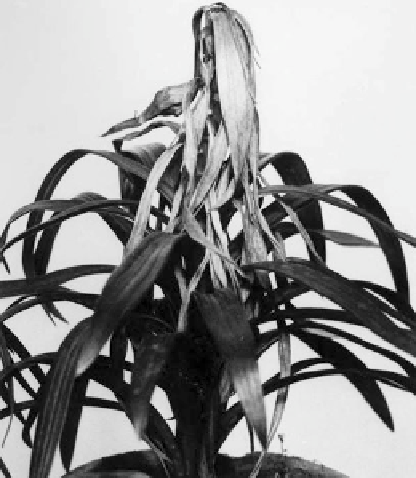Biology Reference
In-Depth Information
strawberry;
Fern Nematode
, a leaf nematode.
A bud parasite of strawberry from Cape Cod to
Maryland and found in scattered localities along
the Pacific Coast. This is a cold-weather species,
persisting through the winter with several thou-
sand nematodes present in a single bud as leaves
unfold in spring. The foliage is small twisted,
thickened, glossy, with swollen petioles; blossom
buds are killed or poor, and no fruit is set. Some
plants are killed; others recover.
As the fern nematode, or begonia leaf blight
nematode, this species is recorded on anemone,
aquatic plants (
Cabomba
sp.,
Limnophila
sp.,
Peplis
sp., and
Potamogeton
sp.), begonia,
bouvardia, calceolaria, chrysanthemum, clema-
tis, coleus, crassula, dianthus, doronicum, fern,
geranium, hosta, hydrangea, Lamium, lily,
peony, primrose, saintpaulia, scabiosa, zinnia,
and other ornamentals. Fern leaves have
a patchy or blotched appearance with dark
brown to black areas on the fronds. In some
species these are rather narrow dark bands from
midrib to border, limited by parallel side veins; in
bird's-nest fern there is a profuse brown discol-
oration from the base halfway up the leaf.
On begonias the disease is most serious on
semituberous varieties grown in greenhouses.
Small brown spots with water-soaked margins,
on underside of leaves, enlarge, coalesce, turn
dark brown, and become visible on the upper
surface. Whole leaves may turn dark; plants
may be stunted. On fibrous-rooted begonias
spots stay small, and leaves become shiny with
a tendency to curl, lose color, and drop. Nema-
todes are spattered from plant to plant by syring-
ing or careless watering; there is no disease
spread when foliage is kept dry.
Dieback of Easter lilies grown in the North-
west is also attributed to this bud and leaf nema-
tode. Leaves are first blotched with yellow, then
turn brownish, drooping and curling against the
stem (see
Fig. 1
). The nematodes live over in the
bulbs and are splashed from leaves of one plant to
another in the field. Lilies from diseased bulbs
develop “bunchy-top” symptoms, with thick,
twisted foliage and dieback.
Control
Strawberry plants in nurseries should be
inspected and certified in spring. Mother plants,
Fig. 1
Foliar Nematode on Lily
near the end of the dormant period, can be treated
with hot water, 2 min at 127
F. Crop rotation
helps.
Bulbs may be treated with hot water, for 1 h at
111
F. Potted begonias can be submerged, pot
and all, for 1 min at 120
F, or for 3 min at 116
F.
African violets may be treated for 30 min at
110
F, ferns for 10 to 15 min at
the same
temperature.
Aphelenchoides parietinus Causing root-plate
and scale necrosis of bulbous iris.
Aphelenchoides ritzemabosi
Chrysanthemum
Foliar Nematode
, common and serious on this
host in home gardens and greenhouses, first
reported in New Jersey in 1890. It is also recorded
on dahlia, zinnia, and some other ornamentals but
possibly confused with
A. fragariae
.
A morphologically similar species produces
a yellow bud blight of Vanda orchids. The first
symptoms are dark spots on areas on underside of
leaves, but by the fifth day after infestation
discolored veins stand out sharply on upper leaf
surface, and diseased leaves turn brown or black,
starting in distinctive wedge-shaped areas
between veins (see
Fig. 2
). Later the leaves dry,
wither, and hang down along the stems. The
nematodes swim from the soil up the stem in


